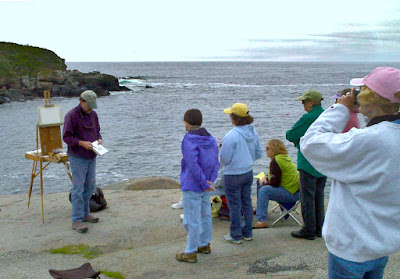 |
| "Cottonwood Days" / 12x16 Oil Based on AI-generated image |
In my previous post on AI (Artificial Intelligence), I wrote about what AI image generation is and how it works. In this post, I'll share an idea of how AI may be useful to what I call the "get your hands dirty" painter.
First, let me say that, for me, AI can never replace what I do as an artist. Making art is all about touch—holding a brush or pastel stick, stirring a pile of paint with a knife, drawing an expressive line with a lump of charcoal. You get none of this tactile satisfaction when you feed prompts to an AI.
Yet I have a curious mind, and recently I wanted to see if the technology could help an artist like me. In the studio, I use reference material gathered in the field—photographs, pencil sketches, color studies—to create a work that is more "considered" and finished than a painting I can do en plein air. Would it be possible to use an AI-generated image as another reference for painting?
I proposed a process: Submit a few field references to the AI along with a text prompt describing the scene, and then use the generated image to paint from.
On Midjourney, the AI platform I'm experimenting with, there's a large community of artists. Most of them, it seems, work purely digitally and using text prompts only. (A text prompt might go something like: "Dragon and mountain from Tolkien, intricate details, Frank Frazetta style." See below for the result.) Others feed the AI sketches along with text prompts and then fine-tune the result through image editing software like Topaz. After an informal poll of users, I determined that few or none are doing what I wanted to do, which is to use the generated image as a reference for painting in traditional media.
Prompting with an image is easy. Prompting with text, not so much—especially if you want to send the AI down a certain path. You can get all kinds of wacky, nightmarish results if you don't consider carefully your choice of words. Although there's an abundance of documentation on using Midjourney, I will say that this platform is not for the novice computer user. Even with many years as a systems analyst, programmer and all-round computer geek (yes, I had a life before art), I found the learning curve steeper than I had hoped. I won't get into all the technical bits here, as that's not my goal. But I do want to share with you the process and the results of two experiments.
Experiment 1: Image Prompt (color study, pencil sketch) + Text Prompt
Here are the two images submitted, one a color study, the other a pencil sketch:
Here is my text prompt:
impressionist oil painting of a rocky cliff with faint candy stripes situated by a calm lake, clouds bathed by sunset light
Here is the first result, a grid of four images:
I decided not to paint any of these, as they are too different from the actual scene, which is more accurately depicted in the color study. I also thought the trees were a little strange, if not downright frightening.
Experiment 2: Image Prompt (color study, photo) + Text Prompt
Here are the two images submitted, one a painting, the other a photo:
Here is my text prompt:
cottonwood trees, autumn, impressionist style oil painting
Here some results, grids of four images:
I decided to take these three:
 |
| "Cottonwood Days" 12x16 oil |
I like the painting I made, and I think the experiment was successful. But honestly, I might have been able to do pretty much the same by just looking at fine paintings of scenery on the web or in Southwest Magazine if I truly needed the inspiration—and I wouldn't have had to learn how to write a useful text prompt. Will I use the AI in the future? Probably not, but if this sort of thing interests you, go for it. Let me know how it goes.




.jpg)





























